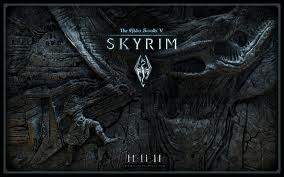Slowly descending the snowy mountains, approaching the Imperial camp, panic fills the hearts of the hand bound rebels. Your guiltless character, having crossed the border into “Skyrim,” finds himself among the suspected rebels and becomes entangled in their executions. The cart escorting the prisoners to their executions moves slowly through the small, urban town. The houses, few in number, crowd around a tower in the middle of the village.
The cart stops and fear surrounds the prisoners who are aware of their fates. They step out of the cart one by one as their names are read from an imperial scroll. As the first rebel approaches the execution block, a shriek pierces the silence of the mountain landscape. Although questioning the source of the sound, the executioner is ordered to proceed with the execution. The first prisoner lies down and is decapitated.
Next, your character approaches the block ready to accept death, but again the sound pierces the air. A moment later, an enormous black dragon soars around the crest of a mountain and lands on the town’s tower. Spikes cover the dragon’s black, scaly skin, and his eyes, two small red ovals, stare directly at your character. Emitting a powerful cry, the blast of the dragon backs the gathered party away from your character, allowing him to escape his execution.
This opening scene of the Elder Scrolls V: “Skyrim” starts the game off fast, wasting little time in character creation or storytelling.
There is a big difference between open world games with lots of content, which many have, and those with a lot of creatively designed content like you’ll find in the Elder Scrolls V: “Skyrim”. The fifth version of Bethesda Game Studio’s long-running role playing game series, released September 11, 2011, is an incredible game. Also the developer behind the Fallout series, Bethesda Game Studios specialized in the action RPG genre, receiving praise for their many innovations to the category.
Even though this is their fifth installment of a medieval RPG, they manage to make many improvements that keep the idea fresh. Even after over 100 hours of play you’ll still uncover quests, items, and characters that lead to undiscovered territory and unexpected results. Not only is “Skyrim” one of the best games of 2011, it is one of the best role-playing games ever made.
The world of “Skyrim”, a mountainous tract of fantasy land lashed by vast spines of rock-strewn mountains, forests, fields, and crumbling catacombs, is brought to life through staggering attention to detail. The visuals are stunning, from the swirling mist along distant mountain tops, to the incredible detail etched into every weapon, spell effect, piece of armor, and structure. Joey Kishpaugh ’12 notes that “the scenery makes me want to cry because it is so beautiful.”
Within this space you’re given the freedom to live however you want. “It’s easy to get wrapped up in a game like “Skyrim” where you have the ability to choose to do whatever you want,” says Wheeler Nakahara ’13. Live in a house and line the shelves with books, attack everyone you see, follow along with quest assignments, or simply wander. It’s really up to you.
I doubt anyone will experience the story of “Skyrim” in quite the same way. You could do the main quest first and figure out why the dragons have returned and how your life ties into their fate. You could visit the College of Winterhold for magical training, visit the Dark Brotherhood if you’re the nefarious type, or call on the Companions, the “Skyrim” equivalent of the fighter’s guild. After a few hours, your quest log will be filled with tasks, from more substantial side quests to an ever growing check list of miscellaneous tasks.
Since the days of Oblivion, Bethesda has learned a lot about how to make characters less artificial. Conversations flow naturally instead of mysteriously pausing the flow of time after every time you say hello. Animations, however, can sometimes be stiff and character models, specifically faces, still look a little blocky. But overall, what you find in “Skyrim” is a dramatic improvement over previous Elder Scrolls games.
Not every story told in “Skyrim” manages to impress, but given the vast amount of content contained within it, so much of it is interesting and a remarkable achievement. It also doesn’t hurt that you’re treated to an achingly beautiful soundtrack throughout your journey. No game can instill such a powerful sense of adventure and discovery as the Elder Scrolls V.
When you’re not charging across the country through fog, snow, or sunlight in search of your next conquest, you’ll often be fighting. The same basic ideas of Bethesda’s franchise still apply here for character development and leveling, but they differ in quite a few ways. At the beginning of the game, you select only a race. There is no need to select major skills or anything like that. Instead, you’re given the freedom to choose what you want to specialize in after you’ve had the opportunity to try it out first hand.
Michael Boone ’13 exclaims, “In “Skyrim” I can make my avatar a 7-foot tall creature named Karlor. If you meet me outside the Red Tavern, I can show you where the treasure is.” Leveling in “Skyrim” happens through skill use. Shoot a fireball, and your “destruction magic” will increase, make a potion to level your alchemy skill, or craft armor to boost your smiting. Once enough of these skill categories are leveled up, your overall character level increases. You’re no longer forced to make so many important decisions at the beginning of the character creation screen. Instead you make decisions at your own pace, so it’s easy to avoid making choices you’ll later regret.
The resulting experience simply makes more sense and it’s easier to see the effects of your decisions. Leveling also gives you perk points to gain abilities or the ability to store them if you are not sure what yet to use. For example, in level 1, you gain damage bonuses and even the chance to decapitate. Though the weapon combat system, like in Elder Scrolls games past can feel floaty, like your slicing through air instead of an enemy, the combat does get better if you choose to invest in related perks. Although there is still room for improvement, the close range weapon combat is the best it’s been in the series, and the third person combat has been much improved.
The spell system has received a number of changes as well for the better. Spells can be seen set as active in both hands and can be cast independently. That means you can shoot fire from one hand while healing or covering yourself in a magic shield in the other. It’s a sensible and flexible system and one that is better once you unlock dual casting abilities that allow you to cast the same spell from both hands for enhanced effects. This leads to the other major upgrade system, dragon shouts. You don’t need “magika” to cast these, so if you’ve been ignoring spells, you can still breathe fire, slow time, blast force waves, or call in dragons.
Learning more shouts is tied to exploration. Finding word walls around “Skyrim” expands your abilities, but you can’t access these shouts until you kill a dragon and absorb its soul. Dragon encounters happen all over “Skyrim”. Some beasts patrol the same area while others can be found randomly in the wild.
Though “Skyrim” gets so many things right, not everything about the game is perfect. As tends to be the case with games of this caliber, there are a few bugs to be encountered. These bugs, which can be as minor as glitchy character models or as strange as teleporting mammoths, are sprinkled throughout the game. Expect to find these bugs in your run through of “Skyrim”, but do not expect them to be serious enough to majorly impact the gameplay.
“Skyrim” is available on the Xbox 360 and PS3 as well as the PC. Although the two consoles are usually seen as the preferred gaming medium, the PC version does boast better graphic capabilities. Compared to its competitor the PS3, one would think that the Xbox would suffer slightly from a graphic standpoint; however, this is not the case for this game. Having been designed for the Xbox, “Skyrim” actually runs cleaner and looks more polished on this system that it does on the PS3. This can be explained by the porting of the Xbox version over to the PS3.
Although both versions will run smoothly at 60fps, the textures of the Xbox version are clearer and less fogy. Finally the PC version will run depending on how well your computer’s capabilities are. Most home computers will not be able to run Bethesda’s new game. The minimum of a dual-core processor at 2.4GHz and a GPU equivalence of the NVIDIA GeForce 8800 GTS 640MB is needed to process the graphics. If however you can run the game on the PC, the rewards of additional mods and add-ons can greatly extend the life of the game.
“Skyrim” is a massive and beautiful game. It maintains the vast open-world structure of past Elder Scrolls games and is filled with creatively designed content that provides a huge amount of flexibility as to how you level up your character. Bethesda has created a world that feels real, that feels like it existed long before you arrived, and that will continue to exist long after you leave.
Few games ever released can inspire such a powerful desire to explore, and even fewer games can provide rewards that make continued gameplay worthwhile. “Skyrim” is a rare game that can, and does, exceed these expectations. Overall, I give “The Elder Scrolls V: “Skyrim”” a 9.5 out of 10.






